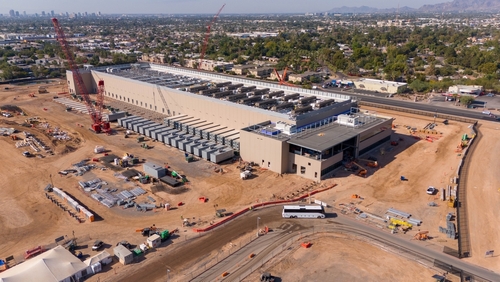Sometimes a friend with a bee in their bonnet about some issue suggest that it would be a good subject for this column.

Friend Ruth was one such, suggesting I write about the health hazards of data centers. She hooked me up with Erin Sanzero, president of Protect Stafford (https://eidsolutions.net), who in turn has a bit of a bee-in-her-bonnet about the environmental impact and the health hazards of these centers that are being built because of the explosion of artificial intelligence (AI).
Her “bee” more specifically is that people are not aware of the impact. Protect Stafford is not out-and-out opposed, she says, but wants people to know what they – or their county supervisors - are getting into.
When I started digging, I realized I was the kind of person that Sanzero was targeting as I did not appreciate all of the downside of these centers that are repositories for zillions of computers, servers and other IT equipment, that need large quantities of electricity to process all that “thinking,” and large quantities of water for cooling.
Health Issues
Of prime interest to me is the health impact - some of which are a threat to people living close by or those working in one of these centers. Things like:
- Noise pollution – especially the low frequency emissions from the cooling machinery as it tends to carry.
- Light pollution with centers lit-up 24/7.
- Exposure to noxious chemicals used in the centers.
- Some also worry about the not very well substantiated issue of electromagnetic hypersensitivity– think Saul’s brother in Better Call Saul.
More worrisome and having a much wider environmental impact are unavoidable features of AI in general, are things like:
- Air pollution – in the immediate vicinity of the centers from the diesel back-up generators needed if there is loss of power – or even if the regular grid just can’t keep up. They will be run for testing even when there is not an emergency, but it seems very unclear how much they will be run. Generators emit nitrogen oxide and particulate matter that are a threat to anyone with lung disease (the calculation is that even if emissions are only 10% of the permitted level, the data center backup generators registered in Virginia would cause an extra 14,000 asthma symptom cases and a total public health burden of $220-300 million per year).
- Power needs – which are already overtaxing supply and people’s electric bills are going up. The prediction is that the demand of these “hungry hippo’s” as Sanzero calls them, is projected to double in the next five years compared to the past decade.
- Water needs – which are in the order of hundreds of thousands of gallons a day for each center, needing data centers to be near water – which is why Rt 3 east is such a favored site. Even if the water is returned to the river there are concerns about warming and adding chemical contaminants.
- Damage to the environment in general – rezoning to allow large intrusive buildings on scenic agricultural and wet-lands. Also, water run-off, roads, and access issues in general, all adding up to the general impact on the quality of life these centers will have.
- Carbon footprint – applying more to the evolution of AI as a whole, the manufacture of all the components tends to have a significant polluting effect. Also, the power-grid connections will be obtrusive.
Reservations
As a medic I guess my main concern should be those things that have an immediate health impact – air pollution, exposure to chemicals, noise, and light. But the scale of the development that’s going on is a threat to the environment. And of note is NPR reports Virginia is a “data hot spot” with “the world's highest concentration of data centers” — nearly 600 facilities of varying sizes” and 150 of them the largest kind, known as “hyperscale” data centers.
The allure to supervisors is tax revenues with minimal infrastructure needs – no kids that need schools. Little traffic to need roads once built.
In what Sanzero described to me as “Mae West style, we’re open for business” mode, localities are offering generous tax breaks as an inducement – though I was interested to read how several projects had not fulfilled their promise. Had not created the number of jobs they anticipated. Had not done as much construction as promised and are being asked to refund the inducements they got.
Some question if this epidemic of data centers isn’t just a temporary phenomenon and technology will move on and make them obsolete – already there is talk of mini nuclear generators providing the power needed.
Also, much of the demand for AI seems somewhat flippant. Should we be destroying our environment so people can store more pictures than they will ever look at? Our kids can play – and become indoctrinated by – violent video games? We can make idiotic memes of our most reviled politicians? And so on.
What would happen if we just said “no”?
Would we be like King Cnut, unable to hold back the tide? The barons of industry, with their massive riches – and therefor massive influence – will surely try to forge ahead.
If we think the downside outweighs the upside, our only hope is our local elected politicians, which includes those all-important supervisors. So, get informed, get involved. There are crucial decisions being made right now.

